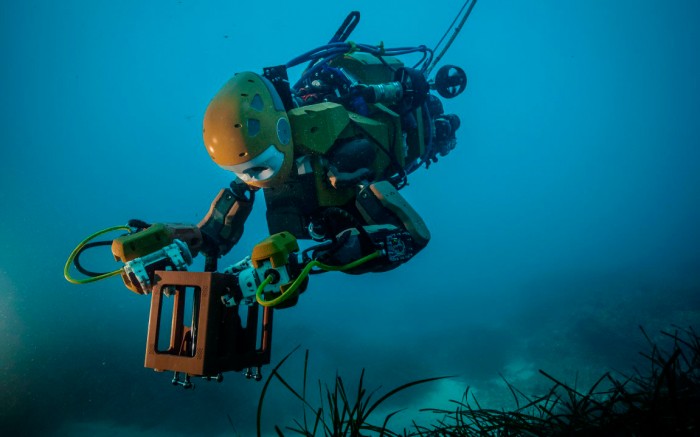A Treasure-Hunting Ocean Robot
This “robotic mermaid” could be more than just a clever way to retrieve sunken treasure (and disappoint amorous sailors). It hints at how humans and robots may someday work together in all sorts of difficult environments.
The submersible humanoid robot, called OceanOne, was developed at Stanford University. It recently retrieved priceless artifacts from King Louis XIV's La Lune, a 350-year-old galleon wrecked off Toulon in southern France in 1664.
OceanOne has two arms, a head, and a tail-like appendage fitted with motorized propellers. It was developed in the lab of Oussama Khatib, a professor at Stanford University, who used a set of computer joysticks to control the robot on its first dive to La Lune from aboard a ship floating above. The robot returned video footage from stereoscopic cameras and provided haptic feedback, allowing Khatib to feel (in a crude sense) what it was grasping.

“The intent here is to have a diver diving virtually,” Khatib explains in a video about the robot (see below). “It’s almost like you are there—you create a new dimension of perception.”
Importantly, OceanOne is also partly automated. It’s possible for the operator to take full manual control, but usually the robot will keep itself positioned correctly by sensing current and turbulence and activating its propellers accordingly. It will also avoid obstacles automatically.
Human-robot collaboration could be important in situations such as repairing a stricken nuclear reactor. But a contest set up by DARPA last year to simulate that scenario showed how difficult it can be to operate complex machinery remotely in an unstructured environment, especially if the communication link is patchy. The underwater setting is similarly challenging.
OceanOne can withstand far greater pressures than a human diver, potentially enabling it to take on many more deep-sea tasks that are too dangerous to be done by hand. The robot may, for example, end up repairing oil rigs or maintaining underwater communication lines.
More significantly, the robot could inspire a new generation of remote-controlled robots that work with their operators in a more intelligent way.
(Read more: Stanford News, “Why Robots and Humans Struggled with DARPA’s Challenge”)
Keep Reading
Most Popular
Large language models can do jaw-dropping things. But nobody knows exactly why.
And that's a problem. Figuring it out is one of the biggest scientific puzzles of our time and a crucial step towards controlling more powerful future models.
How scientists traced a mysterious covid case back to six toilets
When wastewater surveillance turns into a hunt for a single infected individual, the ethics get tricky.
The problem with plug-in hybrids? Their drivers.
Plug-in hybrids are often sold as a transition to EVs, but new data from Europe shows we’re still underestimating the emissions they produce.
Google DeepMind’s new generative model makes Super Mario–like games from scratch
Genie learns how to control games by watching hours and hours of video. It could help train next-gen robots too.
Stay connected
Get the latest updates from
MIT Technology Review
Discover special offers, top stories, upcoming events, and more.